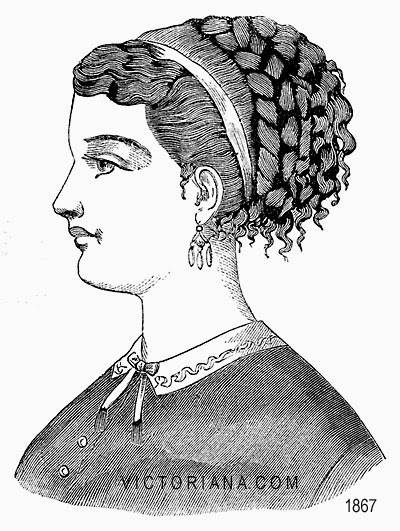Long hair during this period was seen as extremely desirable, and the epitome of femininity, which lead to an obsession with hair. Women would brush their long locks 100 times each night, however this would make the hair very greasy as it stimulated the sebaceous glands too much. Hair was pulled up because when left down it was seen as a sexual symbol. Drawing it up and making the front a focal point became more popular, with adornments such as pearls, ribbons, feathers and flowers such as white and red Japanese rose, accompanied with the hair being a dark colour. Moreover, ringlets around the face were smaller than they used to be.
This hairstyle consists of a waved texture at the front and curls at the back that are surrounded by a large plait.
This comprises of small, tight curls at the front and the back of the hair, and a horizontal plait that extends down the shoulder.
To achieve this, small curls would be present at the front, the hair would be waved at the back and two plaits would extend down and be fastened together.
Hairstyles at the beginning of the century were rather elaborate but still quite muted, they consisted of curls and waves and fastenings. Tight curls were very popular.
Moreover, from portraits it is apparent that middle partings were commonplace along with slick, smooth hair as above.
1860's-1890's:
During this period, fringes were introduced into Victorian hairstyles. And as fashion changed, so did hairstyles, for example the longer the dress, the longer the length of the hairstyle. It also focused on the crown of the head. Different types of buns and chignons had their rise and fall, as did false hair. To begin with both were enormously popular, as was dying the hair still, however both lost their popularity.
For example here, there is a large focus on the crown of the head where an elaborate hairstyle has been formed, and hair extends down the neck with long ringlets. They would use floral adornments to decorate the hair.
 |
| http://www.milkywayjewels.com/vintagephotos/Victorian-Stag-M-Broch.jpg |
This photo from the 1880's shows the beginning of fringes and its new appearance in hairstyles. This would have been more of a day to day style as it is quite simplistic, whereas evening hairstyles were more like the one above.
 |
| http://demodecouture.com/hair/hair_second.html |
A turning point for victorian hairstyles during the 1870's was the creation by french hairdresser M. Marcel Grateau of a natural looking curl which was created by turning a curling iron upside down.
When in these large, drawn up hairstyles, they would usually be held with decorated combs and pins. False hair was still used and for the purpose of creating rolls and curls, and small fluffy curls were popular. Fringes would usually be fluffy too.
Practice
This is an image of the hairstyle that I have re-created myself.


When looking at the image above I knew that I would need a curling wand in order to create the curls at the front, and it is obvious that they are curled towards the face. As you cannot see what the hair looks like from behind, I believe that this bun would have been appropriate as it would have been able to fit underneath the bonnet and encompasses their love of braids. I have also seen this hairstyle used on interpretations of Miss Havisham.
References
Cox, C., 1999. Good Hair Days: A History of British Hairstyling- Caroline Cox - Paperback, United Kingdom: Quartet Books.
Corson, R., 2005. Fashions in hair: the first five thousand years 3rd ed., United Kingdom: Peter Owen Publishers.
http://www.victoriana.com/Victorian-Fashion/victorianhairstyles-1867.html
http://www.fashion-era.com/hair_hats_180040.htm
http://victorianeracnr.blogspot.co.uk
http://demodecouture.com/hair/hair_early.html
http://www.hairarchives.com/private/victorian1new.htm
When in these large, drawn up hairstyles, they would usually be held with decorated combs and pins. False hair was still used and for the purpose of creating rolls and curls, and small fluffy curls were popular. Fringes would usually be fluffy too.
Practice
This is an image of the hairstyle that I have re-created myself.


When looking at the image above I knew that I would need a curling wand in order to create the curls at the front, and it is obvious that they are curled towards the face. As you cannot see what the hair looks like from behind, I believe that this bun would have been appropriate as it would have been able to fit underneath the bonnet and encompasses their love of braids. I have also seen this hairstyle used on interpretations of Miss Havisham.
Cox, C., 1999. Good Hair Days: A History of British Hairstyling- Caroline Cox - Paperback, United Kingdom: Quartet Books.
Corson, R., 2005. Fashions in hair: the first five thousand years 3rd ed., United Kingdom: Peter Owen Publishers.
http://www.victoriana.com/Victorian-Fashion/victorianhairstyles-1867.html
http://www.fashion-era.com/hair_hats_180040.htm
http://victorianeracnr.blogspot.co.uk
http://demodecouture.com/hair/hair_early.html
http://www.hairarchives.com/private/victorian1new.htm










No comments:
Post a Comment